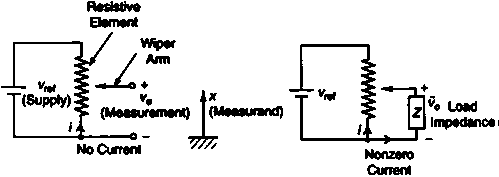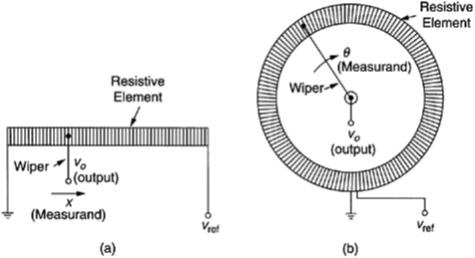SKEDSOFT
Potentiometer
The potentiometer, or pot, is a displacement transducer. This active transducer consists of a uniform coil of wire or a film of high-resistive material—such as carbon, platinum, or conductive plastic—whose resistance is proportional to its length.
A constant voltage uref is applied across the coil (or film) using an external dc voltage supply.
The transducer output signal uo is the dc voltage between the movable contacts (wiper arm) sliding on the coil and one terminal of the coil, as shown schematically.
Slider displacement x is proportional to the output voltage: uo=kx
This relationship assumes that the output terminals are in open-circuit; that is, a load of infinite impedance (or resistance in the present dc case) is present at the output terminal, so that the output current is zero. In actual practice, however, the load (the circuitry into which the pot signal is fed—e.g., conditioning, interfacing, processing, or control circuitry) has a finite impedance.
Consequently, the output current (the current through the load) is nonzero. The output voltage thus drops to even if the reference voltage uref is assumed to remain constant under load variations (i.e., output impedance of the voltage source is zero); this consequence is known as the loading effect of the transducer.
Under these conditions, the linear relationship would no longer be valid, causing an error in the displacement reading.
Loading can affect the transducer reading in two ways: by changing the reference voltage (i.e., loading the voltage source) and by loading the transducer.
To reduce these effects, a voltage source that is not seriously affected by load variations (e.g., a regulated or stabilized power supply that has a low output impedance), and data acquisition circuitry (including signal-conditioning circuitry) that has a high input impedance should be used.
The resistance of a potentiometer should be chosen with care.

(a) Schematic diagram of a potentiometer, (b) Potentiometer loading.

Practical potentiometer configurations for measuring: (a) Rectilinear motions; (b) Angular motions.